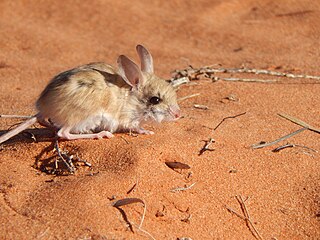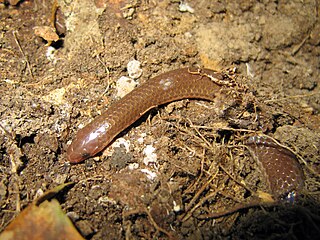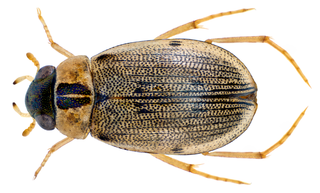
The dusky hopping mouse, is a small rodent endemic to Australia, inhabiting desert regions characterised by sand dunes. Populations have experienced significant declines since the arrival of Europeans, and continue to be subject to threatening processes. It is currently listed as a threatened species.

The Universal Wrestling Federation was a 1986 re-branding of wrestler-turned-owner Bill Watts' Mid-South Wrestling promotion. Watts' goal was to elevate his promotion from a relatively smaller, regional-level business, to a national-level rival of the World Wrestling Federation. However, Watts' business strategy quickly swung from "overnight" success to catastrophic failure, resulting in the 1987 sale of the UWF to another rival: Jim Crockett Promotions. The promotion began as an NWA territory, NWA Tri-State, founded by Leroy McGuirk in the 1950s. Tri-State/Mid-South/UWF promoted in Oklahoma, Arkansas, Louisiana and Mississippi until 1987.

Hydrophilidae, also known colloquially as water scavenger beetles, is a family of beetles. Aquatic hydrophilids are notable for their long maxillary palps, which are longer than their antennae. Several of the former subfamilies of Hydrophilidae have recently been removed and elevated to family rank; Epimetopidae, Georissidae, Helophoridae, Hydrochidae, and Spercheidae. While the majority of hydrophilids are aquatic, around a third of described species are terrestrial, mostly belonging to the subfamily Sphaeridiinae.

Berosus is a lunar impact crater that is located in the northeast part of the Moon, less than one crater diameter northwest of Hahn. Further to the east-northeast is the large crater Gauss, and to the north-northwest lies Bernoulli. Because of its location, this crater appears foreshortened when viewed from the Earth.

Locus amoenus is a literary topos involving an idealized place of safety or comfort. A locus amoenus is usually a beautiful, shady lawn or open woodland, or a group of idyllic islands, sometimes with connotations of Eden or Elysium.

Carphophis is a genus of small colubrid snakes endemic to the United States. The genus consists of two species.

Carphophis vermis is a species of small, nonvenomous colubrid snake native to the United States.
The pleasant bolo mouse, or pleasant akodont, is a species of rodent in the family Cricetidae. It is found on grassland at high altitudes in Bolivia and Peru.

The yellow-pine chipmunk is a species of order Rodentia in the family Sciuridae. It is found in western North America: parts of Canada and the United States.
Calymmaderus amoenus is a species of beetle in the family Ptinidae.

The eastern worm snake is a subspecies of the worm snake, Carphophis amoenus, a nonvenomous colubrid endemic to the Eastern Woodlands region of North America. The species' range extends from southwest Massachusetts, south to southern Alabama, west to Louisiana and north to Illinois. This species is common in the ecotone between woodlands and wetlands. It may also be found in grasslands adjacent to woodlands. Though this snake can be abundant in parts of its range, it is rarely seen because of its fossorial lifestyle. When not underground, C. a. amoenus resides mostly under rocks, logs and leaf litter, or burrowed within rotting woody debris. This snake is perfectly safe to pick up, as it cannot bite, but may produce a foul-smelling excretion.
Copelatus divisus is a species of diving beetle. It is part of the genus Copelatus in the subfamily Copelatinae of the family Dytiscidae. It was described by Chris Watts in 1978.

Carphophis amoenus, commonly known as the worm snake, is a species of nonvenomous colubrid snake endemic to the eastern United States. C. amoenus can be found east of the Mississippi, from southwest Massachusetts south to southern Alabama west to Louisiana and then north to Illinois. This species of snake protects a large range, and normally prefers a moist habitat in the rocky woodlands, under rotten wood of logs and stumps. Though this snake is quite abundant over its range, it is rarely seen because of its dormant lifestyle and where it usually resides. This snake is most common on the edges or in the ecotonal areas of open to thick woodlands, and the borders of wetlands. It may also be found in the grasslands next to woodlands. The best chance to spot it is after heavy rains, when its small size and distinct color make it easy to spot. This species prefers moist soil inhabited by earthworms, which are its main prey, so the soil needs to be sufficiently moist. The snake's skin naturally evaporates water; so the soil needs to be moist enough to offset this. C. amoenus is mostly found under rocks and in sufficient leaf litter during the extreme daytime heat.

Berosus is a genus of beetles in the family Hydrophilidae, the water scavenger beetles. The genus contains 273 species. It is distributed worldwide.
Calyptrocalyx amoenus is a palm species in the family Arecaceae, and is native to Papua New Guinea and to the Indonesian part of New Guinea, Western New Guinea.

Berosus pulchellus, is a species of water scavenger beetle found in Oriental, Australasian, Afrotropical and Palaearctic regional countries such as India, Sri Lanka, Hong Kong, Japan, Iran, Cambodia and Australia.
Batrachomatus nannup is a species of diving beetle in the family, Dytiscidae, first described as Allomatus nannup in 1978 by Chris H.S. Watts. The holotype was collected in Bridgetown, Western Australia. In a generic revision in 2013, Lars Hendrich and Michael Balke synonymised AllomatusMouchamps, 1964 with Batrachomatus Clark, 1863, thus changing the species name.
Amphiops micropunctatus is a species of water beetle in the family Hydrophilidae, first described by Chris H.S. Watts in 1998.
Amphiops austrinus is a species of water beetle in the family Hydrophilidae, first described by Chris H.S. Watts in 1998.
Allocotocerus yalumbaboothbyi is a species of water beetle in the family Hydrophilidae, first described by Chris H.S. Watts in 1998.










